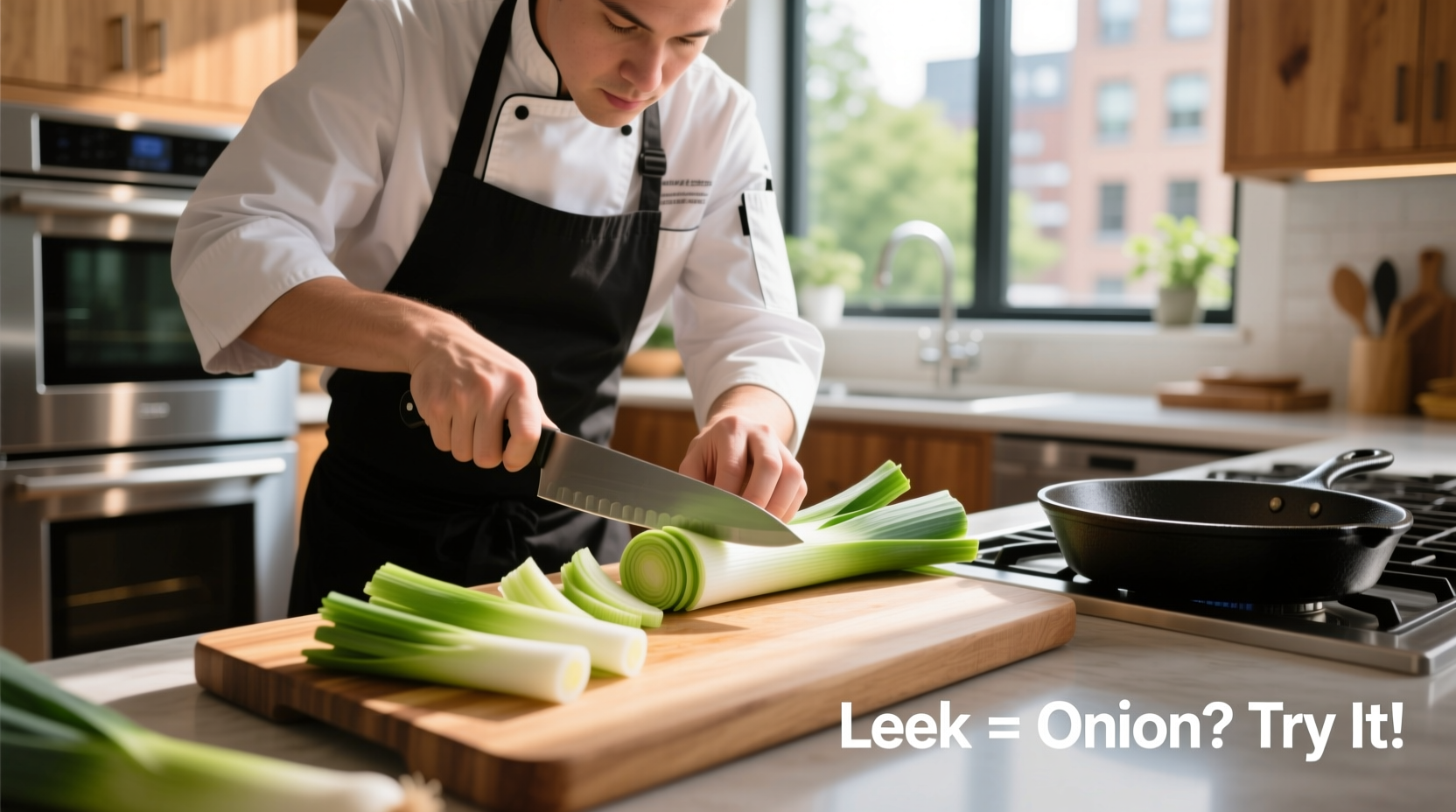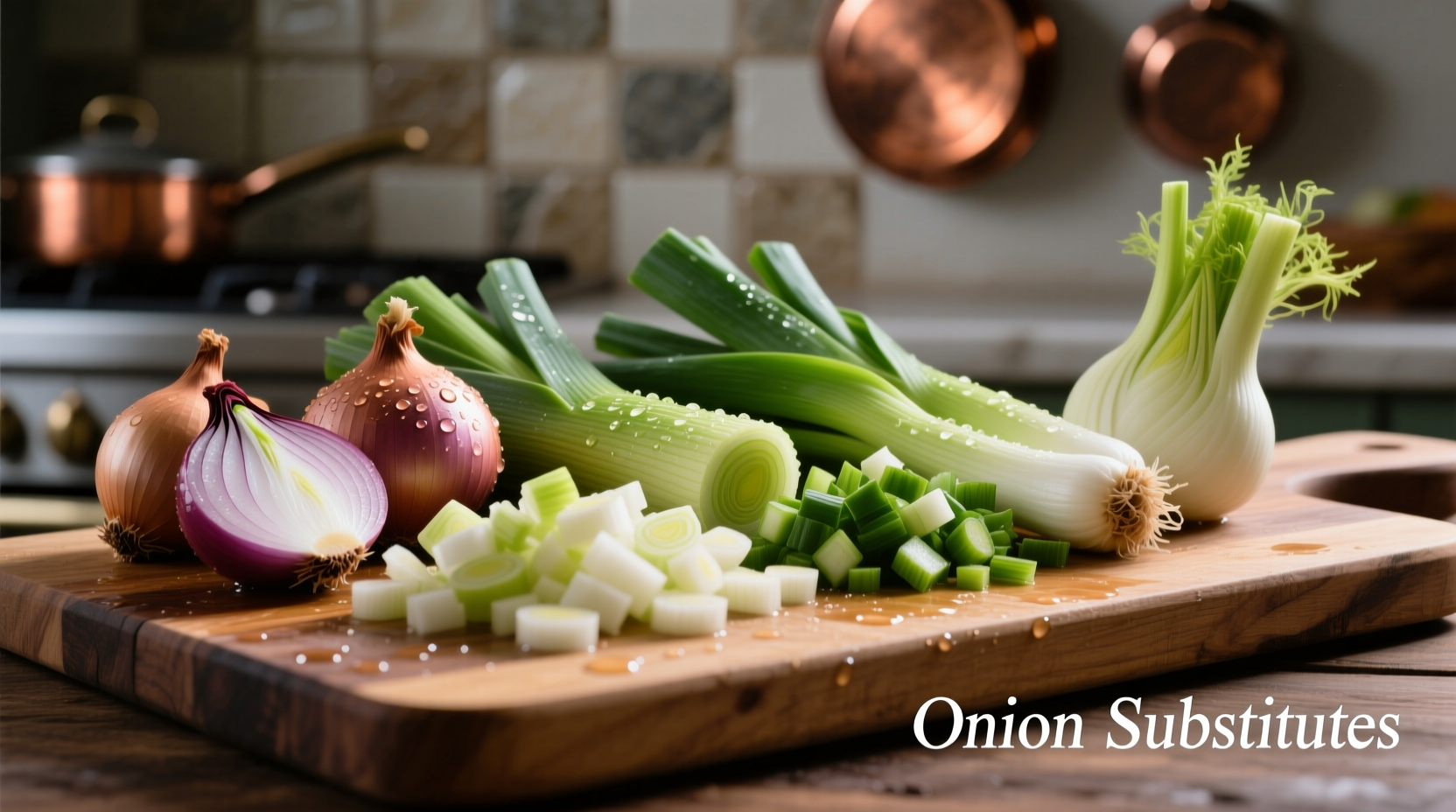If you're reaching for onion substitutes, you're likely in one of three situations: you've run out of onions mid-recipe, someone in your kitchen has an allium allergy, or you're modifying a dish for dietary restrictions. Understanding which substitute works best for your specific cooking scenario makes all the difference between a dish that merely survives the substitution and one that actually shines.
Why Onion Substitutes Aren't One-Size-Fits-All
Onions contribute three critical elements to cooking: flavor compounds (particularly organosulfur compounds), texture, and moisture content. The right substitute depends on which element matters most for your specific dish. According to research published in the Journal of Food Science, the flavor profile of onions changes dramatically when cooked versus raw, which explains why some substitutes work better in certain applications.
| Substitute | Best For | Substitution Ratio | Flavor Notes |
|---|---|---|---|
| Leeks | Cooked dishes, soups, stews | 1:1 (white parts only) | Milder, sweeter, less pungent |
| Shallots | Vinaigrettes, sauces, raw applications | 1:1 | More delicate, subtle garlic notes |
| Asafoetida (hing) | Indian cuisine, lentil dishes | 1/8 tsp = 1 medium onion | Strong sulfurous aroma when raw, mellow when cooked |
| Fennel | Roasted vegetables, seafood dishes | 1:1 (bulb only) | Distinct anise flavor, best when caramelized |
Top Onion Alternatives for Specific Cooking Scenarios
Cooking Without Onions: The Professional Chef's Toolkit
Professional kitchens maintain several onion alternatives depending on the dish requirements. When developing recipes without onions, chefs consider both the chemical composition and functional properties of potential substitutes.
For Raw Applications (Salsas, Salads, Garnishes)
Scallions (green onions) provide the closest raw onion experience when white onions aren't available. Use the green parts for milder flavor and the white parts for stronger onion notes. For those with allium sensitivities, diced cucumber with a splash of vinegar creates surprising textural similarity without the problematic compounds.
The National Center for Biotechnology Information notes that allium vegetables contain fructans that cause digestive issues for some people. For low-FODMAP alternatives, try infused oils like onion-infused olive oil (where the problematic compounds don't transfer to the oil).
For Cooking and Caramelizing
Leeks stand out as the most versatile cooked substitute. Their white and light green parts caramelize beautifully and provide similar texture to onions. For best results, slice leeks lengthwise to prevent disintegration during cooking. When substituting in French onion soup, increase the cooking time by 5-7 minutes since leeks contain more moisture.

For Allium Allergies and Sensitivities
Asafoetida (hing) remains the gold standard for Indian cuisine when onions aren't an option. This resin from the Ferula plant contains similar sulfur compounds to onions but without the problematic fructans. Monash University's FODMAP research team confirms that pure asafoetida is low-FODMAP in typical culinary amounts.
For Western dishes, celery and carrots in a 2:1 ratio creates the "holy trinity" foundation used in many French and Italian recipes. The celery provides necessary moisture while carrots contribute natural sweetness that develops during cooking.
When Substitutes Fall Short: Managing Expectations
No substitute perfectly replicates onions in all applications. Understanding these limitations prevents kitchen disasters:
- Burgers and meatloaf: Onions provide both flavor and moisture retention. Without them, add 1-2 tablespoons of broth per pound of meat
- Onion rings: No adequate substitute exists - consider zucchini or eggplant rings instead
- Raw onion applications: Vinegar-soaked radishes provide similar bite but different flavor profile
Advanced Substitution Techniques
Professional chefs employ several techniques to maximize substitute effectiveness:
- Layering flavors: Combine 1/2 shallot with 1/4 cup diced fennel for complex onion-like flavor
- Temperature control: Cook substitutes over lower heat for longer to develop sweetness without burning
- Acid balancing: Add lemon juice or vinegar to compensate for missing sulfur compounds
When developing recipes without onions, track how substitutes behave during different cooking stages. The flavor transformation timeline shows why certain substitutes work better in specific applications:
| Cooking Stage | Leeks | Shallots | Asafoetida |
|---|---|---|---|
| Raw | Mild, slightly sweet | Sharp, pungent | Extremely strong, unpleasant |
| 5 minutes cooking | Sweetness develops | Sharpness mellows | Aroma transforms completely |
| 15 minutes cooking | Caramelized, rich flavor | Nutty, complex | Blends seamlessly into dish |
Special Dietary Considerations
For those following low-FODMAP diets, the Monash University team has verified several onion alternatives. Their research shows that the green tops of scallions (spring onions) are low-FODMAP in amounts up to 65g, while the white bulb remains high-FODMAP. This provides a valuable option for garnishing dishes without triggering symptoms.
When cooking for histamine intolerance, avoid shallots and leeks as they're high in histamine. Instead, use asafoetida or the green parts of scallions, which have been verified as low-histamine options by the Histamine Intolerance Awareness Group.
Practical Substitution Guide by Cuisine
Mexican and Latin American Dishes
For salsas and guacamole, try jicama diced to match onion size. It provides similar crunch without the allium flavor. In cooked dishes like mole or bean stews, use a combination of roasted poblano peppers and celery for depth.
Asian Cuisine
For stir-fries, substitute half the onion with thinly sliced bell peppers. The USDA FoodData Central shows bell peppers contain similar moisture content (92% vs onion's 89%) which prevents sauce dilution. In Japanese dishes, use small amounts of grated daikon radish for similar pungency without strong onion flavor.
Mediterranean and European Dishes
French mirepoix traditionally uses 2 parts onion, 1 part celery, 1 part carrot. When omitting onions, increase celery to 1.5 parts and add 1 part fennel bulb. This maintains the flavor foundation while accommodating dietary needs.
Final Tips for Successful Substitution
Always consider these factors when choosing onion substitutes:
- Moisture content: Adjust cooking times for substitutes with higher water content
- Flavor development timeline: Some substitutes need longer cooking to reach optimal flavor
- Acid balance: Onions contain natural acids that affect overall dish pH
- Color impact: Some substitutes (like fennel) change dish appearance
When in doubt, start with smaller amounts of substitute and taste as you cook. Most experienced chefs recommend keeping onion powder in your pantry as a last-resort substitute - just 1 teaspoon equals one small chopped onion, but use sparingly as it can become bitter if overused.











 浙公网安备
33010002000092号
浙公网安备
33010002000092号 浙B2-20120091-4
浙B2-20120091-4